Use of captured German 30 mm guns after the end of World War II
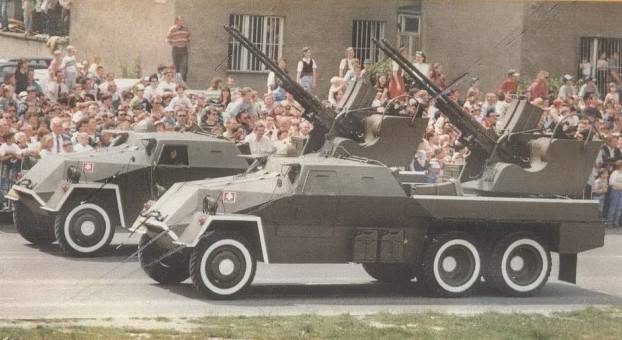
Germany became a pioneer in the creation aviation and anti-aircraft 30-mm guns. Guns of this caliber are an intermediate link between 20 and 37-40 mm artillery systems. In terms of the power of action and the effective range of fire, 30-mm shells are significantly superior to 20-mm ammunition, and at the same time, 30-mm artillery systems have significantly less weight than 37-40-mm ones, and, as a rule, significantly exceed them in terms of rate of fire and ammunition ready to fire.
30-mm MK.103 aircraft gun and anti-aircraft guns based on it
The Luftwaffe leadership and German specialists in the field of aviation weapons already in the mid-1930s came to the conclusion that it was necessary to create rapid-firing aircraft guns with a caliber of more than 20 mm, but less than 37 mm. The 30-mm caliber was considered optimal, providing a good balance between projectile power, rate of fire and weight weapons. In addition to the Luftwaffe, the navy expressed interest in such weapons: sailors planned to equip seaplanes with 30-mm cannons with high ballistics and use them against enemy surface submarines and combat boats.
The experience with the 30-mm MK.101 cannon (Maschinenkanone 101), created by Rheinmetall-Borsig AG and put into service in 1940, was not very successful. The operation of the MK.101 automation was based on a short barrel stroke. The use of magazine feed (with a capacity of 10-30 rounds) limited the rate of fire to 260 rounds/min and made it difficult to place the gun on board the aircraft. The weight of the gun with a 30-round drum was 185 kg. The length of the gun is 2592 mm. Due to its significant mass and dimensions and due to the limited magazine capacity, this aircraft gun has not become widespread.
The positive thing about stories with MK.101 for the Luftwaffe was the creation of a very successful shot with a dimension of 30x184 mm. Armor-piercing incendiary projectile weighing 455 g, with an initial speed of 760 m / s, when hit at a right angle at a distance of 300 m, could penetrate 32-mm armor. Subsequently, an armor-piercing tracer sub-caliber projectile was introduced into the ammunition load of a 30-mm aircraft gun, which at a distance of 300 m, when hit at an angle of 60 °, could penetrate 50-mm armor.

30 mm armor-piercing incendiary shot for the MK.101 gun
At the beginning of 1943, the production of an improved 30-mm MK.103 aircraft gun began, which managed to get rid of many of the shortcomings of the previous model. The new gun without ammunition weighed 145 kg. The mass of a box with a tape for 100 shots is 94 kg. The scheme of functioning of automation is mixed: the extraction of the sleeve, the supply of the next cartridge and the advancement of the tape occurred due to the short rollback of the barrel, and the removal of powder gases was used to cock the bolt and unlock the bore. The barrel bore was locked by a longitudinally sliding bolt with lugs retracting to the sides. German designers used the ignition of the primer due to an electric discharge. The contact was transmitted from the onboard electrical network through the gun body, barrel and sleeve to the electric ignition sleeve and closed to the “contact drummer”, which, in fact, ignited the charge. The MK.103 was powered by a loose metal strip with a length of 70-125 shells. Rate of fire - up to 420 rds / min. The range of a direct shot was 800 meters.

30 mm MK.103 aircraft gun
The ammunition load of the 30-mm MK.103 cannon was significantly expanded. The most effective when firing at air and unprotected ground targets turned out to be: the 330-gram high-explosive projectile 3 cm M.-Gesch. o. Zerl., containing 80 g of TNT, and 320 grams of high-explosive tracer 3 cm M.-Gesch. L'spur o. Zerl., filled with 71 g of phlegmatized hexogen mixed with aluminum powder.
For the manufacture of particularly powerful 30-mm projectiles with a high explosive filling ratio, the technology of "deep drawing" was used, followed by hardening of the steel case with high-frequency currents.
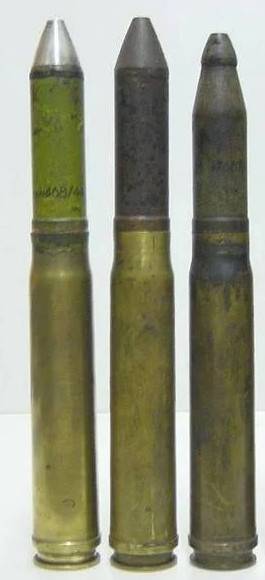
30-mm rounds for the MK.103 cannon from left to right: high-explosive, high-explosive tracer, high-explosive self-destruct
The damaging effect of a single 30mm high-explosive projectile was comparable to the hit of three or four 20mm fragmentation tracer projectiles fired from a 2 cm FlaK 38 mount.
Only one production aircraft with the MK.103 cannon installed in the engine camber is known - Do.335, and of the single-engine fighters, only the wings of the Fw.190 and Ta.152 could withstand the recoil and weight of the MK.103 placed in hanging containers. Therefore, 30-mm guns of this type were installed mainly on heavy twin-engine fighters and attack aircraft.
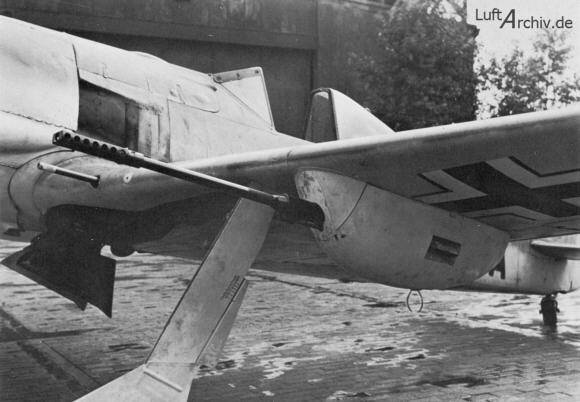
Underwing 30-mm MK.103 cannon on the Fw.190F-8 aircraft
According to the complex of combat characteristics, the MK.103 occupied an intermediate position between the Soviet 23-mm VYa and 37-mm NS-37 and was one of the best serial aircraft guns created during the Second World War. This cannon had a significant impact on the development of aviation cannon weapons in the postwar period. The German MK.103 had a relatively simple and technologically advanced design, comparative ease of disassembly and assembly. However, Soviet specialists who studied the captured MK.103 came to the conclusion that it had a number of shortcomings that made it difficult to use it as part of the armament of single-engine fighters. Too strong recoil required the use of a multi-chamber muzzle brake, and the sharpness of the automation created increased shock loads.
MK.103s were produced in large quantities until February 1945, and a significant number of unclaimed 30-mm guns accumulated in warehouses, which became the reason for their use in anti-aircraft guns.
In the first phase, sometime in early 1943, Luftwaffe ground personnel began mounting 30 mm cannons on primitive and rather crudely made turrets designed to reinforce the air defense of field airfields. But already in the middle of 1943, the specialists of the Waffenfabrik Mauser AG concern handed over for testing the 30-mm anti-aircraft gun 3 cm Flak 103/38, which was supposed to replace the widespread 20-mm anti-aircraft gun 2 cm Flak 38. When creating 3 cm Flak 103/38, a frame was used 2 cm Flak 38.
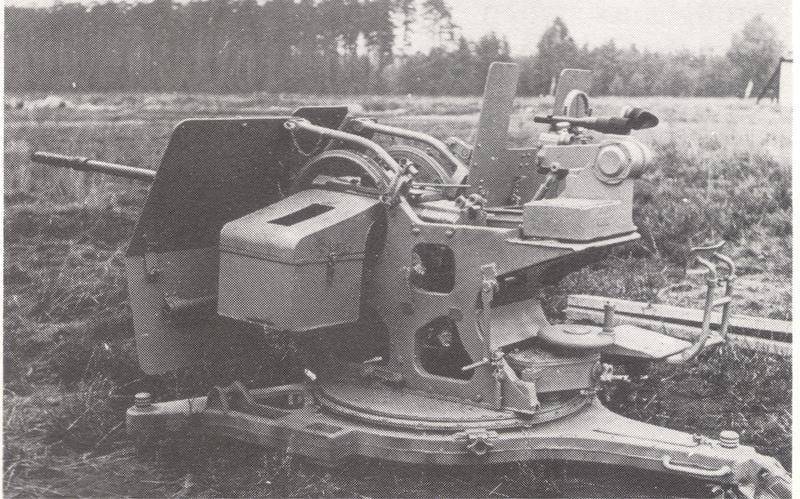
30 mm anti-aircraft gun 3 cm Flak 103/38 in firing position
The transition from 20-mm to 30-mm caliber led to an increase in the weight of the anti-aircraft gun by about a third. The mass of 3 cm Flak 103/38 in the transport position was 879 kg, after the separation of the wheels - 619 kg. Calculation - 7 people.
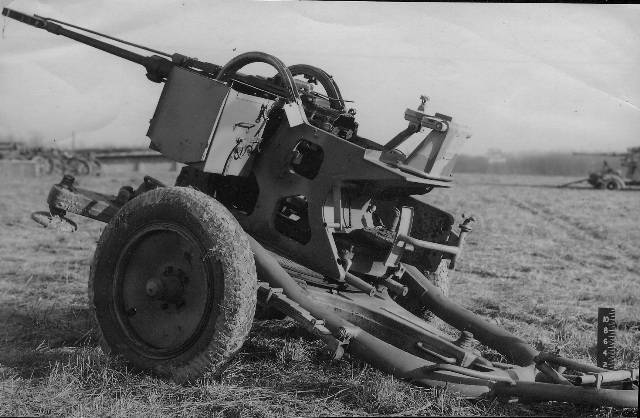
30 mm anti-aircraft gun 3 cm Flak 103/38 in transport position
Due to the use of belt feed and a box for 40 shells, the combat rate of fire increased significantly. The heavier 30-mm projectile lost its energy more slowly, while the maximum slanted firing range at air targets was 5700 m, and the height reach was 4700 m. According to expert estimates, the effectiveness of the 30-mm anti-aircraft gun has increased compared to the 20-mm Flak 38 approximately 1,5 times. 3 cm Flak 103/38 installations were used in stationary and towed versions; they were also placed on the chassis of armored personnel carriers, in the backs of trucks and on railway platforms.
The next step was the creation at the beginning of 1945 of the quadruple 30-mm installation 3 cm Flakvierling 103/38. The most significant external difference between the 30 mm quadruple mount and the 20 mm 2 cm Flakvierling 38 was the longer and thicker cannon barrels, equipped with a multi-chamber muzzle brake.
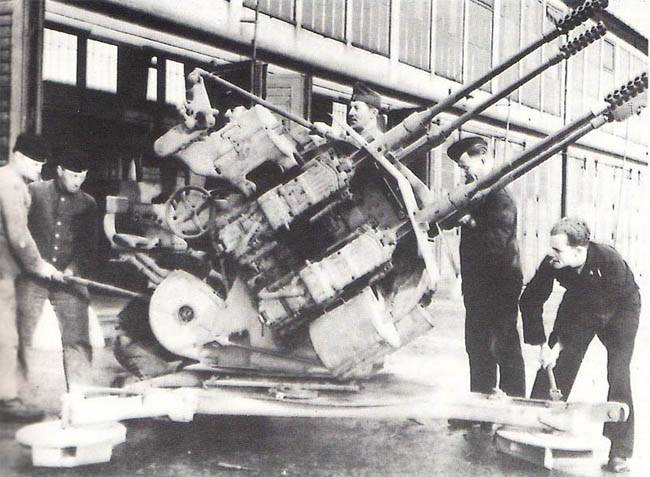
30-mm quad anti-aircraft gun 3 cm Flakvierling 103/38
The weight of the 3 cm Flakvierling 103/38 compared to the 2 cm Flakvierling 38 increased by about 30%, which was more than offset by increased combat characteristics - firing range, increased destructive effect of the projectile and higher combat rate of fire. The quadruple 30-mm installation was superior in firepower to all rapid-fire anti-aircraft guns of the Second World War; in 6 seconds it could fire 160 shells with a total mass of 72 kg in a continuous burst.
Quadruple German 30-mm anti-aircraft guns had high combat characteristics, but, fortunately for the combat aviation of the Red Army and the allies, they released few of them. The total order of the German Ministry of Armaments for 30-mm installations was 2000 3 cm Flak 103/38 and 500 3 cm Flakvierling 103/38, but the industry of the Third Reich, due to overload and lack of raw materials, was unable to provide the planned production volumes. In total, approximately 500 single-barrel and several dozen quad installations were handed over to the customer, and due to their relative small number, they did not have a significant impact on the course of hostilities.
Czechoslovakia became the only country where in the post-war years 30-mm anti-aircraft guns, previously used in the armed forces of Nazi Germany, were in service in noticeable quantities.
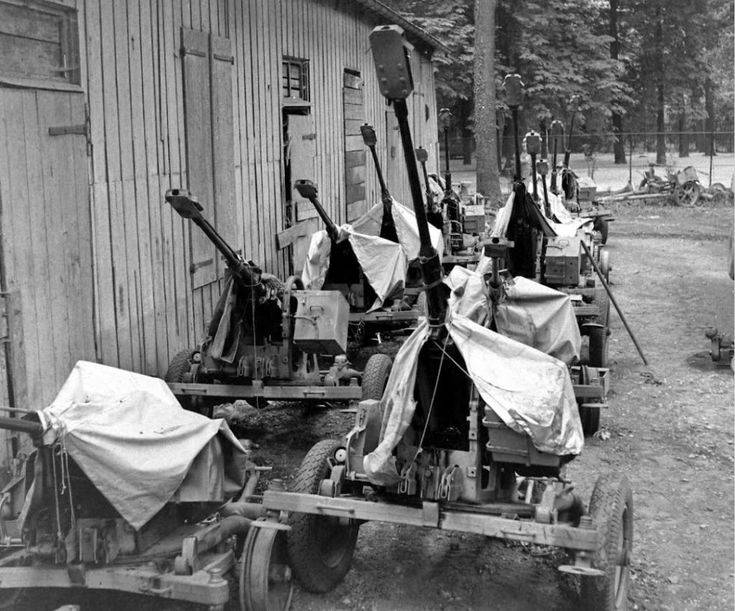
30-mm anti-aircraft guns 3 cm Flak 103/38 in the warehouse of captured weapons
Several batteries equipped with 3 cm Flak 103/38 anti-aircraft guns, deployed in stationary positions, covered military airfields. 30-mm anti-aircraft guns, along with 20-mm machine guns and captured 88-105-mm German anti-aircraft guns, served in the air defense of Czechoslovakia until the end of the 1950s.
Twin 30-mm anti-aircraft installation 3 with m Flakzwilling MK 303 (Br)
Based on the developments of the Krieghoff waffenfabrik company, which designed 20-30 mm aircraft guns during World War II, the designers of Waffenwerke Brünn (as the Czech Zbrojovka Brno was called in wartime) commissioned the Kringsmarine to create a twin 30 mm anti-aircraft gun 3 cm MK. 303 (Br) (also known as 3 cm Flakzwilling MK. 303 (Br)). The main reason for the creation and adoption of twin 1944-mm anti-aircraft guns in the second half of 30 was the desire of German admirals to have much lighter installations on small-displacement ships and submarines, with a rate of fire at least twice as high as the 37-mm 3,7 cm Flak M42 machine guns. , while maintaining the same effective firing range. The existing 30-mm belt-fed anti-aircraft guns based on the 30-mm MK.103 cannon did not tolerate exposure to sea water, required careful maintenance, and were not very reliable when used on deck.
The prototype for the 3 cm MK.303 (Br) was the experimental aircraft gun MG.301, the automatics of which combined a combination of a short barrel recoil, the stroke of which unlocked the bolt, and a gas outlet that reloaded the weapon. Czech specialists have made significant changes to the design of the artillery unit. It was decided to increase the practical rate of fire of the anti-aircraft installation through the use of twin 30-mm artillery guns.
For firing from 3 cm MK.303 (Br), powerful 30 mm shots with a sleeve length of 210 mm were used. A projectile weighing 330 g was accelerated to an initial velocity of more than 1000 m/s. The rate of fire reached 500 rds / min.
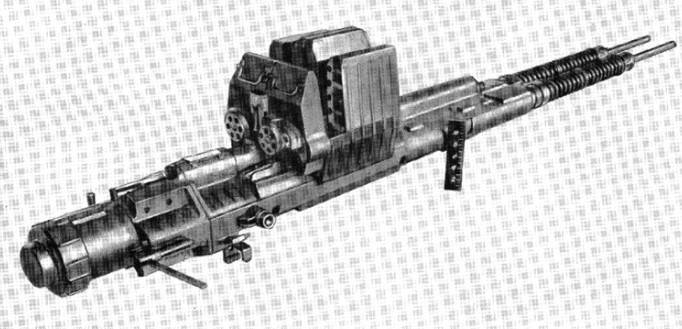
Artillery part of a 30-mm twin anti-aircraft gun
To increase reliability, the tape feed was abandoned, and magazines for 10 or 15 shots were used. With a total rate of fire of 900 rds / min, the combat rate of fire reached 150 rds / min. The length of the gun became longer and, together with the muzzle brake, amounted to 3145 mm with a barrel length of 2,2 m, and the weight increased to 185 kg. The total weight of the anti-aircraft installation was approximately 1600 kg. Circular shelling was provided, vertical aiming angles: from -10 ° to + 85 °.
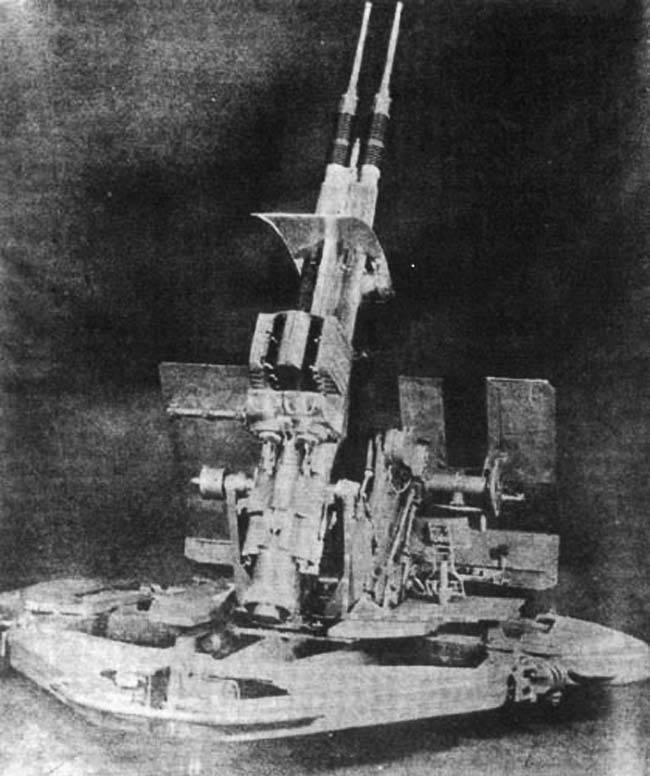
Twin anti-aircraft gun 3 cm MK. 303 (Br)
In order to preserve the resource of the barrel and reduce the impact loads of automation, the weight of the powder charge was reduced, after which the initial speed was 910 m/s. The effective range of fire on aircraft reached 2500 m.
English-language sources say that by the end of 1944, the Brno plant produced 32 copies of the 3 cm Flakzwilling MK.303 (Br), and during the first four months of 1945, another 190 copies. The 3 cm Flakzwilling MK.303 (Br) anti-aircraft guns, designed for arming warships, were mounted on decks to a very limited extent and were mainly used permanently at coastal facilities.
Based on the twin installation 3 cm Flakzwilling MK 303 (Br) in the early 1950s, Zbrojovka Brno engineers designed a towed 30-mm double-barreled anti-aircraft gun M53, which was put into service as ZK.453 mod. 1953
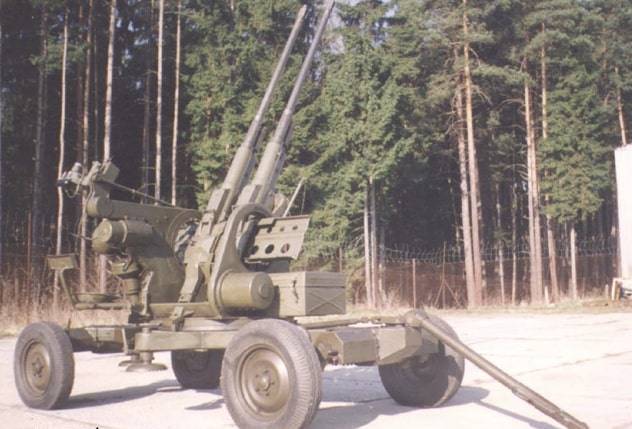
Towed 30-mm anti-aircraft installation ZK.453
The total rate of fire from two barrels reached 1000 rds / min. But since the anti-aircraft installation was powered from rigid cassettes for 10 shells, the real combat rate of fire did not exceed 100 rds / min. The ammunition included armor-piercing incendiary tracer and high-explosive fragmentation incendiary shells. An armor-piercing incendiary tracer projectile weighing 540 g with an initial velocity of 1000 m/s at a distance of 500 m could penetrate 55 mm steel armor along the normal. A high-explosive fragmentation incendiary projectile weighing 450 g left a barrel 2363 mm long with an initial speed of 1000 m/s. The firing range for air targets is up to 3000 m. The artillery part of the installation was mounted on a four-wheeled cart. At the firing position, she hung out on jacks. Weight in the stowed position 2100 kg, in combat 1750 kg. Calculation - 5 people.
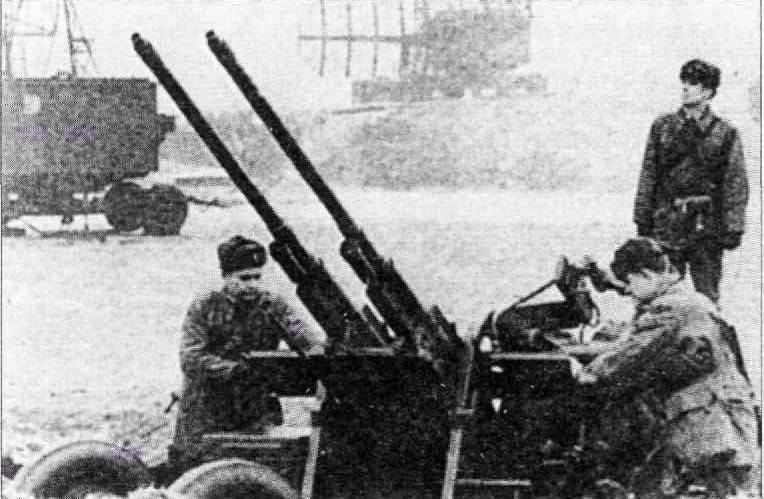
Czechoslovak anti-aircraft installation ZK.453 covers the position of the radar complex
Towed ZK.453 anti-aircraft guns were reduced to batteries of 6 guns, but if necessary, they could be used individually. The main disadvantage of the ZK.453, like the Soviet ZU-23, is its limited capabilities in poor visibility and at night. She did not interface with the radar fire control system and did not have a centralized guidance station as part of the battery.
Comparing the ZK.453 with the Soviet-made 23 mm ZU-23, it can be noted that the Czechoslovak mount was heavier and had a lower combat rate of fire, but at the same time, the effective shelling area was about 25% higher, and its projectile had a greater destructive effect. 30-mm ZK.453 installations were supplied to Yugoslavia, Cuba, Guinea and Vietnam.
Towed ZK.453 installations had low mobility and a relatively low combat rate of fire, which did not allow them to be used for anti-aircraft cover of transport columns and motorized rifle units. In order to eliminate these shortcomings in 1959, the Praga PLDvK VZ self-propelled anti-aircraft gun was adopted. 53/59, which received the unofficial name "Jesterka" - "Lizard" in the army. The wheeled ZSU weighing 10 kg had good cross-country ability and could accelerate to 300 km/h. Cruising on the highway 65 km. Crew 500 people.
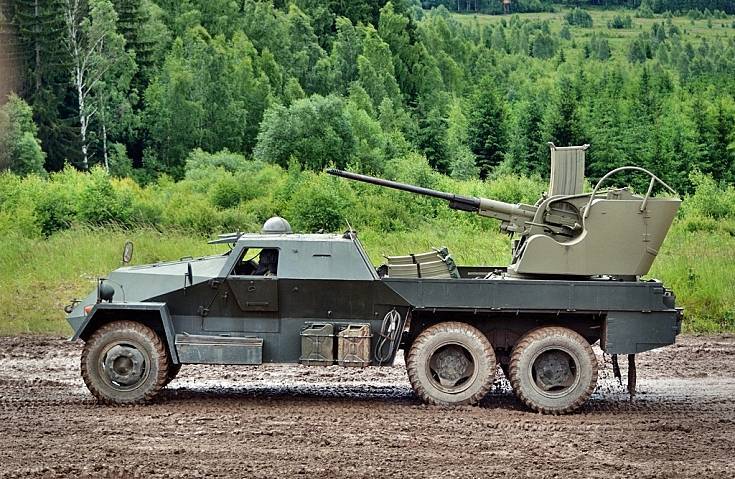
ZSU PLDvK VZ. 53 / 59
The basis for the anti-aircraft self-propelled gun was the Praga V3S three-axle all-wheel drive cargo vehicle. At the same time, the ZSU received a new armored cabin. The armor provided protection from rifle-caliber small arms bullets and light shrapnel.
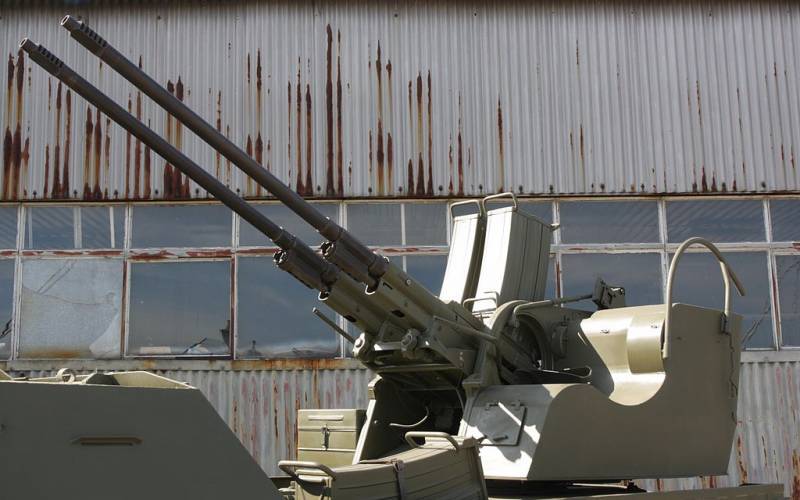
Artillery unit ZSU PLDvK VZ. 53 / 59
Compared to the ZK.453, the artillery part of the self-propelled gun was changed. To increase the combat rate of fire, the power supply of 30-mm anti-aircraft guns was transferred to box magazines with a capacity of 50 rounds. With the mass of one equipped store 84,5 kg, replacing them for two loaders was a difficult procedure that required considerable physical effort. The aiming speed of the twin 30-mm anti-aircraft gun was increased through the use of electric drives. Manual guidance was used as a backup. In the horizontal plane, there was the possibility of circular fire, vertical guidance angles from -10 ° to + 85 °. In case of emergency, it was possible to fire on the move. Combat rate of fire: 120-150 rds / min. The total ammunition in 8 stores was 400 rounds.
An artillery mount using special guides, cables and a winch could be transferred to the ground and used permanently in prepared positions. This expanded tactical capabilities and made it easier to mask the anti-aircraft battery during defensive operations.
Due to the simplicity, reliability and good operational and combat qualities of the ZSU PLDvK VZ. 53/59 was popular with the troops. Until the mid-1970s, the Czechoslovak self-propelled Lizards were considered quite modern air defense systems and, under the designation M53 / 59, were popular on the world arms market. Their buyers were: Egypt, Iraq, Libya, Cuba, Yugoslavia and Zaire. In the Czech Republic, the latest ZSU PLDvK VZ. 53/59 were withdrawn from service in 2003. In Slovakia, until recently, there were approximately 40 self-propelled guns in storage. Also, wheeled ZSUs were preserved in the armed forces of Bosnia and Herzegovina and Serbia.
Wheel ZSU PLDvK VZ. 53/59 were well suited for escorting transport columns and anti-aircraft cover for objects in the rear. But move in the same battle formations with tanks they couldn't. In the mid-1980s, the ZSU BVP-1 STROP-1 was created in Czechoslovakia. It was based on the tracked infantry fighting vehicle BVP-1, which was the Czechoslovak version of the BMP-1. According to the requirements of the military, the self-propelled unit was equipped with an optoelectronic search and sighting system, a laser rangefinder, and an electronic ballistic computer. The ZSU BVP-1 STROP-1 used a remotely controlled artillery unit from PLDvK VZ. 53/59 with an effective range of fire against air targets up to 2000 m.
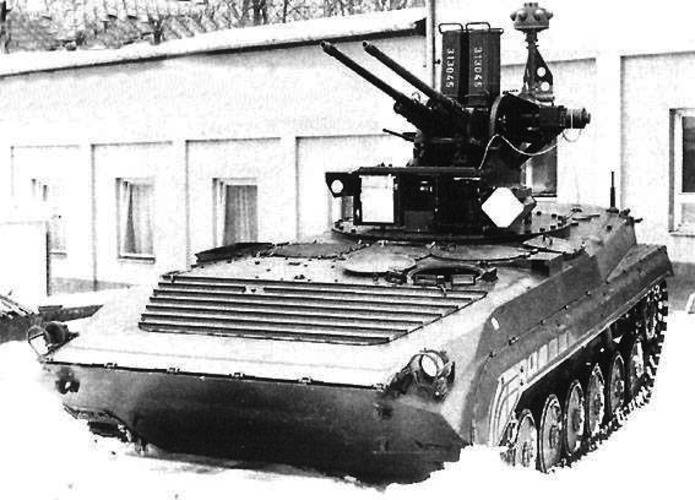
ZSU BVP-1 STROP-1
During tests conducted in 1984, the search system’s ability to detect a MiG-21 fighter at a distance of 10-12 km during daylight hours and determine the distance to it with high accuracy was demonstrated. At the same time, despite the good results achieved by the guidance system during testing, it became clear that the attempt to cross the latest electronics with anti-aircraft guns, which traced their ancestry to the 30-mm guns used by the Germans during World War II, was doomed to failure . In the USSR, since 1965, the ZSU-23-4 “Shilka” with a detection radar was supplied to the troops, and in 1982 the Tunguska anti-aircraft missile and gun system was adopted by the Soviet Army. The use of anti-aircraft artillery machine guns with external box loading was an anachronism at that time, and quite predictably the BVP-1 STROP-1 ZSU was not accepted for service.
30 mm MG.213C/30 aircraft gun
Shortly before the defeat of Nazi Germany, the concern Mauser-Werke AG handed over the 30-mm aircraft gun MG.213C (MK.213C / 30) for testing. In total, until April 1945, ten prototypes were made. It was planned to start deliveries of serial products in June 1945.
Structurally, the MK.213S/30 was similar to the 20-mm MK.213S/20 cannon, work on which was originally carried out by the Krieghoff waffenfabrik company. The weapon's automation was based on a combination of a gas exhaust circuit with a short barrel stroke and a revolving shot-feed circuit, which made it possible to combine several operations and thus increase the rate of fire.

30 mm aircraft gun MK.213S/30
The mass of the gun was 82 kg. Length - 1630 mm. Barrel length - 1295 mm. Rate of fire - up to 1200 rds / min. The 30x85 mm ammunition had an electrical primer ignition system. To reduce the mass of the gun and ensure a high rate of fire, ballistic characteristics had to be sacrificed. A projectile weighing 330 g left the barrel with an initial velocity of 530 m/s.

30 mm shot for the MK.213S/30 gun
After the collapse of the Third Reich, the developers of MK.213С/20 and MK.213С/30 settled in the western zones of occupation, and someone managed to escape to Switzerland. As a result, the 20-mm M39 aircraft gun was created and put into service in the United States, and their own 30-mm counterparts in the UK, France and Switzerland.
The British and French projects based on MK.213 C/30 developed in parallel and did not differ much from each other. So, the British Aden in the original version used an almost exact copy of the German cartridge 30x85B, referred to as 30 x 86B. The French in the DEFA 540 gun tested a slightly more powerful 30x97B ammunition. Later versions of the British Aden Mk.4 and the French DEFA 554 were brought to a single interchangeable 30x113 mm ammunition.
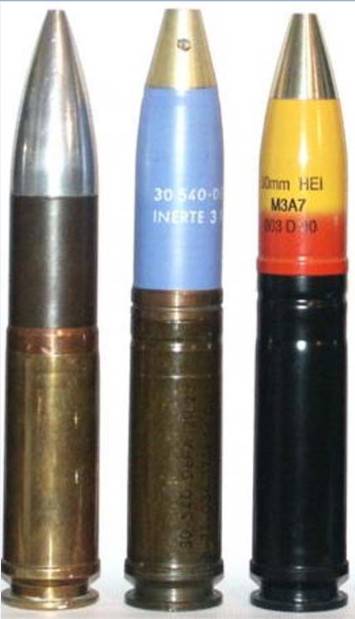
30-mm aviation ammunition: English cartridge 30x86B from Aden guns - a copy of the German 30x85B from MG 213C-30, French 30x97B from DEFA 540 guns, Anglo-French 30x113B from Aden Mk.4 guns
The English gun Aden officially entered service in 1955 and was produced in five versions: Mk.1, Mk.2, MK.4, Mk.5 and Mk.4. The Aden Mk.89 gun had a weight of 1080 kg, a barrel length of 1660 mm, a total length of 1200 mm and a rate of fire of 1250-5 rounds per minute. In the Aden Mk.1500 cannon, the rate of fire has been increased to 30 rounds per minute. The 30 mm Aden guns were fired with standard 113 x 495V cartridges. Cartridge weight 237 g, projectile weight 27 g. The fragmentation projectile contained 805 g of explosive. The initial velocity of the projectile is 2000 m/s. Sighting range - up to XNUMX m.
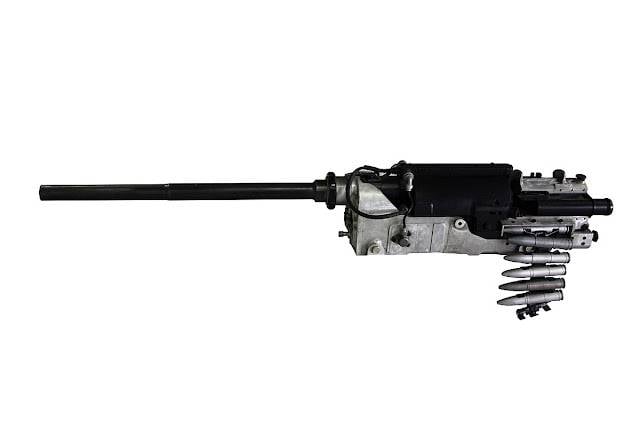
30mm Aden Mk.4 cannon
Aden aircraft guns were used on almost every British aircraft from 1954 until the introduction of the Panavia Tornado in 1980.
The first mass-produced French 30-mm aircraft gun DEFA 551 was installed on Dassault Mystère IV, Dassault Mystère IIC and Sud Aviation Vautour fighters from the mid-1950s. Subsequently, French, Israeli, Argentinean and Swedish-made fighters and attack aircraft were armed with DEFA 552/552A/553/554 cannons.
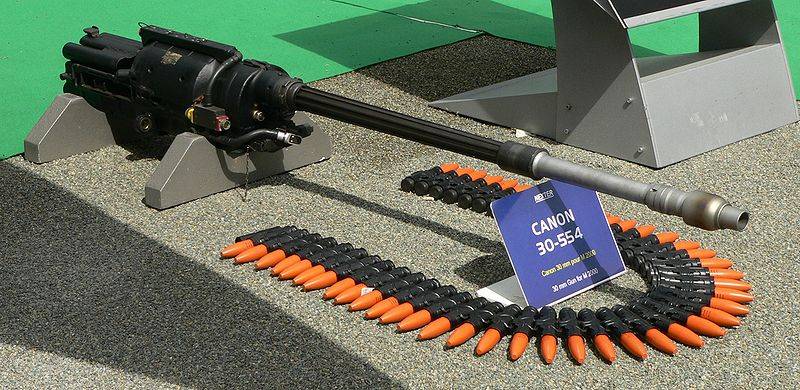
30 mm DEFA 554 aircraft gun
The DEFA 554 gun weighs 85 kg. Length - 2100 mm. The initial speed of the projectile is 765-820 m / s. Rate of fire - up to 1800 rds / min.
In total, from the start of production until the mid-1990s, over 14 DEFA guns of all modifications were produced, which were supplied to 000 countries. This gun, the prototype of which was created more than 25 years ago, is one of the most widespread in the world.
The most powerful 30-mm cannons created on the basis of the MK.213 C/30 were the Swiss Oerlikon 302 RK and its improved modification Oerlikon KCA (Oerlikon 304 RK) chambered for 30x173 mm.

Armor-piercing tracer cartridge 30x173 mm
The Oerlikon 302 RK gun weighed about 200 kg. The total length was 2972 mm. The rate of fire reached 1200 rounds/min. A projectile weighing 300 g accelerated in a barrel with a length of 1982 mm to 1100 m/s, which was significantly higher than in British and French guns, also created on the basis of the German MK.213 C/30.
The Oerlikon 302 RK artillery system was not a commercial success and became a milestone in the development of Swiss small-caliber guns. Several dozen Oerlikon 302 RKs have been purchased by the United States and the United Kingdom for testing. In particular, these 30-mm guns were installed on several American Northrop F-89 Scorpion interceptors.
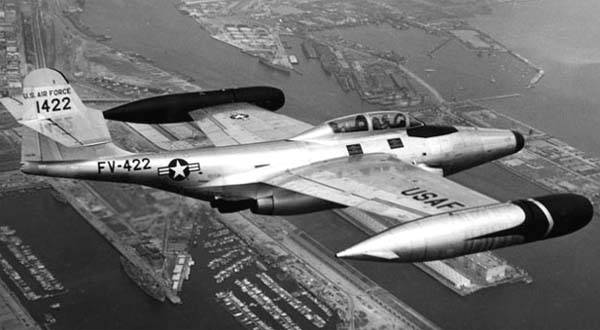
Northrop F-89 Scorpion interceptor
The fate of the 30-mm Oerlikon KCA gun, which was adopted in Sweden under the designation Akan m / 75 and installed on Saab JA-37 Viggen fighters, was more successful.
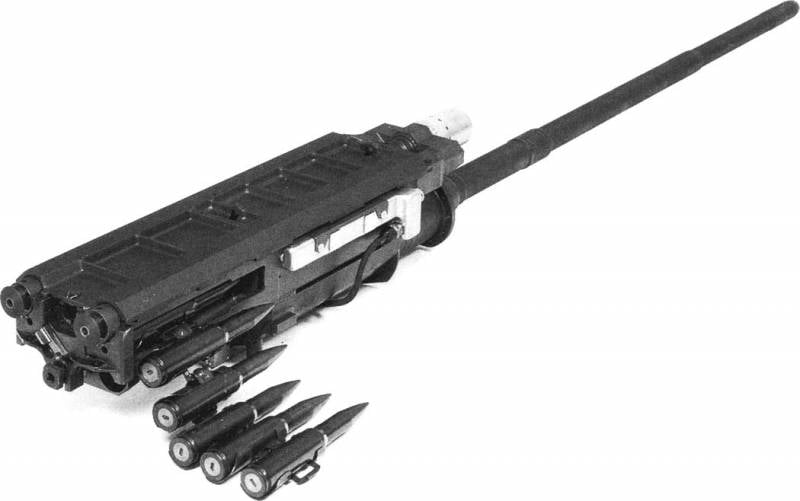
30 mm Oerlikon KCA aircraft gun
Due to the use of powerful ammunition, the Oerlikon KCA gun, even with the use of new materials and design solutions aimed at reducing weight, was quite heavy and overall. The mass of the gun was 136 kg, and the length was 2692 mm. An armor-piercing projectile weighing 235 g left a barrel 1976 mm long at a speed of 1385 m/s. The initial velocity of the 352 g high-explosive fragmentation projectile reached 1050 m/s. The armor-piercing sabot projectile normally easily pierced 40 mm armor of medium hardness. Rate of fire - up to 1350 rds / min.
By the standards of the late 1960s and early 1970s, the Oerlikon KCA gun was considered quite advanced, and the US Air Force became interested in it. The Swiss 30-mm aircraft gun, which received the American designation GAU-9 / A, was considered as the main armament of the Fairchild Republic A-10A Thunderbolt II attack aircraft, but lost the competition to the 30-mm seven-barreled General Electric GAU-8 / A Avenger with a rate of fire of 4200 rounds ./min.
The American company Hughes Helicopters used the GAU-9/A gun in a removable Mk.4 gun container of its production instead of two standard 20-mm M39A3 cannons. The suspended installation with a 30-mm KSA cannon and 125 rounds of ammunition weighed 476 kg. It was tested on the McDonnell Douglas F-E Phantom II fighter as a weapon for assault strikes, but the US Air Force abandoned this option. Subsequently, some of the Northrop F-5E Tiger II export fighters were equipped with nacelles with Oerlikon KCA cannons.
Information